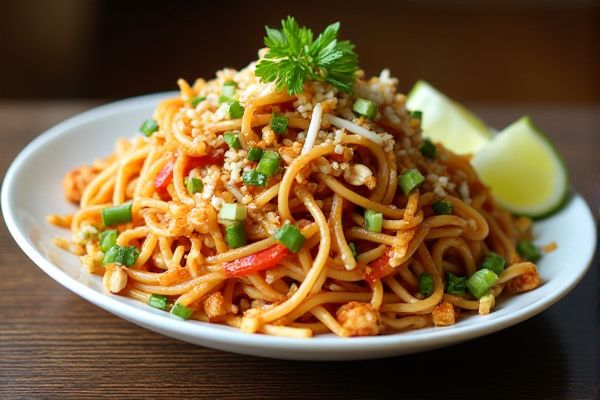
Wagamama's Pad Thai features stir-fried rice noodles tossed with tender chicken, crunchy bean sprouts, scrambled eggs, and chopped peanuts, all coated in a tangy tamarind sauce and garnished with fresh lime wedges for a vibrant and flavorful Thai classic.
Equipments
- Wok
- Spatula
- Chef’s knife
- Cutting board
- Mixing bowls
- Saucepan (for sauce)
- Measuring cups
- Measuring spoons
- Colander or sieve
- Serving plates or bowls
Ingredients
- 8 oz (225g) dried flat rice noodles
- 8 oz (225g) boneless, skinless chicken breast
- 2 large eggs
- 1 cup bean sprouts
- 1/2 cup roasted peanuts
- 2 green onions
- 1 small red chili (optional)
- 2 tablespoons vegetable oil
- 1 lime
- 2 tablespoons tamarind paste
- 2 tablespoons fish sauce
- 1 tablespoon soy sauce
- 2 tablespoons brown sugar
- 2 cloves garlic
- 1 tablespoon rice vinegar
- Cilantro leaves (optional garnish)
Using dried flat rice noodles requires soaking or boiling according to package directions to achieve the perfect texture. Ensure the chicken breast is sliced thinly for even cooking in the wok. Fresh ingredients like bean sprouts, lime, and cilantro brighten the dish, so use high-quality produce for authentic flavor. Tamarind paste is essential for the tangy sauce; substitute carefully if unavailable to maintain taste balance. Your Pad Thai from the Wagamama copycat menu will capture the vibrant, flavorful essence of the original with these key ingredients.
Instructions
- **Instructions:**
- Soak rice noodles in warm water until just tender, then drain.
- Cut chicken breast into thin strips.
- Mince garlic, slice green onions, and chop red chili (if using).
- Roughly chop roasted peanuts.
- Make sauce: In a saucepan, combine tamarind paste, fish sauce, soy sauce, brown sugar, and rice vinegar; heat gently and stir to dissolve sugar, then set aside.
- Heat wok over medium-high heat and add 1 tablespoon vegetable oil.
- Add chicken strips and stir-fry until just cooked through; remove and set aside.
- Add remaining oil to wok and sauté garlic and chili for 30 seconds.
- Push garlic and chili to the side, crack eggs into the wok, scramble until just set.
- Add soaked noodles to the wok, pour in prepared sauce, and toss to coat evenly.
- Return chicken to the wok, then add bean sprouts and green onions; stir-fry briefly to combine.
- Serve immediately, topped with chopped peanuts, fresh cilantro leaves, and lime wedges on the side.
Substitution
Wagamama's Pad Thai is a beloved dish known for its perfect balance of tangy tamarind sauce and tender chicken combined with crunchy bean sprouts and peanuts. You can substitute chicken with tofu or shrimp for a different protein option that suits dietary preferences. Tamarind paste can be replaced with a mix of lime juice and brown sugar if unavailable, maintaining the dish's signature tangy-sweet flavor. Use gluten-free soy sauce to accommodate gluten sensitivity without sacrificing taste. Fresh lime wedges enhance the final dish but lemon juice can also provide a refreshing citrus note.
Tips
Ensure the rice noodles are soaked just until tender to avoid mushy texture during stir-frying. You should cut chicken into thin, uniform strips for even and quick cooking. When making the tamarind sauce, heat gently and stir constantly to fully dissolve the sugar and blend the flavors smoothly. Toss ingredients quickly over high heat in the wok to maintain the noodles' texture and keep the bean sprouts crunchy.
Nutritions
Wagamama's Pad Thai provides a balanced mix of protein, carbohydrates, and healthy fats, primarily from chicken breast, rice noodles, and peanuts. The dish contains approximately 450-550 calories per serving, with protein supporting muscle repair and growth, while tamarind paste and lime wedges add antioxidants and vitamin C. Bean sprouts contribute dietary fiber and essential vitamins, aiding digestion and overall health. Your meal also offers moderate sodium content from fish sauce and soy sauce, so balancing intake is advisable for optimal nutrition.
Storage
Store leftover Pad Thai in an airtight container in the refrigerator for up to 2 days to maintain freshness and prevent moisture buildup. Reheat gently in a wok or microwave, stirring occasionally to ensure even warmth without drying out the noodles or chicken. If your Pad Thai contains fresh lime and cilantro garnish, add them only after reheating to preserve their bright flavor and texture.
Variation or Alternatives
You can substitute chicken breast with tofu or shrimp for a vegetarian or seafood twist on Wagamama's Pad Thai. Instead of tamarind paste, use lime juice mixed with a bit of brown sugar to replicate the tangy sauce flavor. For a crunchier texture, toast the peanuts in the pan before adding them as a garnish. Stir-fry the noodles on high heat for a slightly smoky "wok hei" effect that enhances the dish's authenticity.
Allergies
Wagamama's Pad Thai contains common allergens such as peanuts, eggs, and soy sauce, which may trigger allergic reactions in sensitive individuals. Fish sauce presents a risk for those allergic to fish or shellfish, while chicken and bean sprouts could cause issues for people with specific food sensitivities. Your awareness of these ingredients is essential when considering this dish to avoid potential allergic responses.
Why this recipe?
Wagamama's Pad Thai is loved for its perfect balance of sweet, sour, and savory flavors combined with fresh ingredients like tamarind, lime, peanuts, and rice noodles. The dish offers a satisfying texture and authentic taste that captures classic Thai cuisine in every bite. You can recreate this vibrant and nutritious meal at home, customizing spice levels and ingredients to suit your preference. Trying to make a Pad Thai copycat allows you to enjoy restaurant-quality flavor without the wait, making it a rewarding culinary experience.
